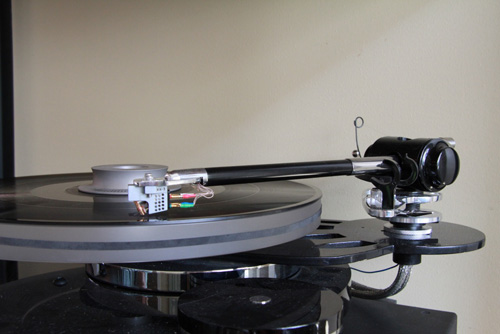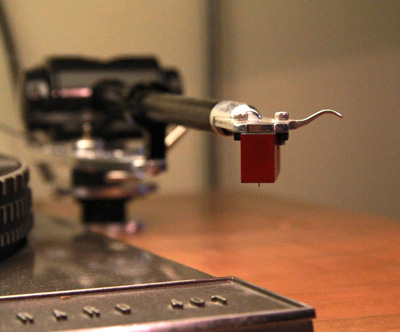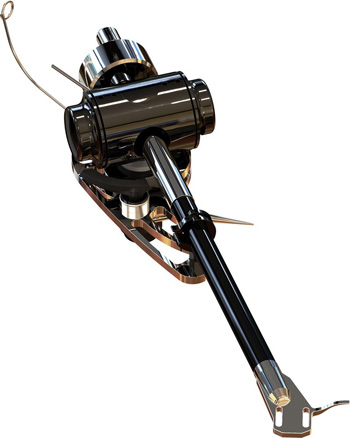| Origin Live Conqueror MK3c Tonearm |
by David McCallum

In the spring of 2011 I wrote a review of
the excellent Origin
Live Calypso turntable
with the equally striking Encounter
MK3C Tonearm. I spent a good
number of months with both products and was thoroughly
impressed with what I heard – so much so
that after the review I asked Origin Live’s
principle owner and designer Mark Baker if I
could set up the combination for The Inner Ear's
editor Ernie Fisher for an extended run of additional
listening.
As the year reached its end, I contacted Mark
about sending back the demo table and arm. However,
after a brief conversation, rather than returning
the whole kit, Mark suggested we up the ante
and offered to send an upgraded tonearm to be
paired with the same Calypso table. His recommendation
was the Conqueror
MK3C.
Tech Stuff
In my 2011 review I wrote technical sections
for both the Calypso turntable and the Encounter
MK3C tonearm. Origin Live also maintains an excellent
website that’s full of useful technical
information about all aspects of their analogue
products, and I would encourage any reader to
spend time referencing their System
Philosophy and Upgrading Brochure,
as well as their Tonearm
Overview. I’ve included
a few details that stood out about the Conqueror,
and asked Mark Baker for some additional comments.
Like the Encounter MK3C, the Conqueror MK3C is
a dual pivot bearing design, a hallmark of the
upper range of Origin Live tonearms. However,
the Conqueror offers improvements in a number
of key areas:
It includes a more advanced Hybrid arm tube composed
of five materials designed to improve dampening
or energy dissipation, which improves transparency,
dynamics and bass performance. Origin Live has
spent the better part of 20 years developing
their composite arm tube. Understandably Mark
wouldn’t elaborate on the materials used,
but the design of the arm tube is clearly something
they are proud of.
The Conqueror utilizes ultra low friction dual
pivot bearings aimed at increasing clarity and
high frequency performance, along with floating
vertical bearings that decouple the arm tube
from the turntable, preventing vibrations and
unwanted energy from adding color to the sound.
Also included is a high strength aircraft alloy
headshell along with an external Linear Flow
2 arm cable, fully balanced and 95% shielded.
In comparison to the Encounter MK3C, there is
a noticeable difference in mass (950g vs. 570g).
The increased mass is due to higher density alloys
being used in the arm yoke and base. Regarding
the additional mass, Mark commented that in the
right place, mass has the effect of adding inertia,
which in turn affects dynamics throughout the
frequency range, extending the bass and adding
power, weight and definition. The Conqueror also
has a heavier effective mass of 14g, up from
the Encounter’s12g. All other basic technical
arm attributes remain the same.
Specifications
Effective length (240 mm), overhang (17.24 mm),
offset angle (23 degrees), mounting distance
from the platter centre to arm hole centre (223
mm) diameter of mounting hole (24 - 25 mm), size
of base mounting nut (32mm A/F), maximum arm
board thickness (27mm), length of external cable
(1.2m), 2m capacitance in pF (130 pF per channel),
capacitance in pF for linear flow 2 cable (340
pF per channel) resistance in Ohms (0.002 ohms).
A Note on Tonearm Compliance
Prior to the Conqueror review, I had been doing
my own research on cartridge compliance and
the relationships amongst a tonearm’s
effective mass, a cartridge’s compliance
and the resulting resonance frequency that
any cartridge and tonearm combination produces.
In the midst of the research, I asked Mark
his opinion and if he could offer some words
on Origin Live’s philosophy on cartridge
and tonearm compatibility. He responded that
he didn’t consider it to be a concern,
mentioning that he gets asked all the time
about compliance and cartridge matching and
the advice he gives is to ignore compliance — in
a low friction, stiff, low resonance, well
designed arm it is not an issue — in
other words compliance is well down the scale
of significant factors to the point of irrelevance
in a good arm.
Mark’s response was particularly relevant
as I planned out the details of my review.
My intention was to use two cartridges, a Dynavector
DV XX2 MKII and a Koetsu Urushi Vermillion
with a Signature Platinum upgrade. Of the two
cartridges one offers a good compliance match
with the Conqueror (Dynavector) and one doesn’t
(Koetsu). The last thing I asked Mark was to
articulate what he is most proud of about the
Conqueror MK3C – it is after all one
of his top arms. He replied that he doesn’t
want to try and sell his products based on
technical specifications:
“The trouble is that if people make decisions based on a technical specification
or even fine sounding technical arguments, it can be hopelessly misleading — I
know it's not very exciting to write about, but I tend to pay a lot of attention
to what stuff sounds like and have theories as to why stuff performs the way
it does. For example why does a 4mm diameter bolt generally sound better than
a 5mm diameter bolt and a 3mm diameter bolt? Not very exciting to write about
and most of the countless hours of development that go into our arms would be
lost as attention to every detail is mind-bogglingly tedious.”
 Arm Set-up and Configuration Arm Set-up and Configuration
I tested the Conqueror MK3C on two turntables with two cartridges. The first
table was the Origin Live Calypso turntable used in last year’s review,
and the second was a vintage Garrard 401 restored by Matthew Taylor at Audio
Grail in Devon, U.K. The plinth for the Garrard was designed and built by Russ
Collinson at Layers
of Beauty in Barnsley, South Yorkshire, U.K.
The custom cherry plinth has interchangeable arm boards and mounting the Origin
Live tonearm onto a Rega arm board cut-out worked perfectly.
Setting up the Conqueror MK3C on the Calypso turntable is fairly simple. The
table includes an attached arm board with a Rega-style mounting hole. The tonearm
base and cable thread through the mounting hole and clamp under the arm board
via a screw-style clamp. Once attached to the table there is a clip that can
be attached underneath the table in order to secure the tonearm wire, while
the arm swings freely on the arm board until the mounting screw is secured
tight. The installation instruction booklet included with the arm suggests
that the clamp be tightened a comfortable amount using only your hand.
Once secured to the arm board, a threaded arm base allows for vertical tracking
angle adjustment (VTA). The vertical tracking force is adjusted via a combination
rear counterweight and smaller fine adjuster that is attached to the counterweight.
Antiskate (or side bias) adjustment can be controlled by a pair of threaded
silver balls — one ball attaches to the tonearm while the other, connected
via a thin tread, sweeps over a wire loop. There are no measurements or dials
for either Antiskate or VTF adjustments. Similar to the Encounter MK3C tonearm,
azimuth is set at the factory and adjustment isn’t recommended.
Mounting the arm onto the Garrard turntable was also simple. The Garrard’s
custom plinth includes multiple arm board cutouts, including a 9” Rega
board. The only real difference was the original mounting position — the
arm needed to sit much higher on the arm board in order to accommodate the
height of the Garrard platter.
The two cartridges used for testing included a rebuilt Dynavector DVXX2 with
a new MKII body, and a Koetsu Urushi Vermillion with Koetsu’s Signature
Platinum upgrade. The Dynavector was used on both the Calypso and Garrard table,
while the Koetsu was used exclusively with the Garrard 401.
Subjective Analysis
For the first week, with the arm mounted onto the Origin Live Calypso table
with the Dynavector cartridge, I spent most of my time listening to folk, modern
rock and jazz music: Wilco, Fleet Foxes, Leonard Cohen, Radiohead, Nico Case,
Miles Davis, Charlie Byrd, Stan Getz, and Wes Montgomery all made their way
onto the table. While I was mostly listening to tunes I knew well, Andrew Bird’s
new album Break It Yourself and Patricia Barber’s Cole Porter Mix were
both given their first listen with the Conqueror, Calypso & Dynavector
combination.
My initial impressions of the arm with the Origin Live table and Dynavector
cartridge were positive. I heard a lot of detail with excellent high frequency
extension, while lower bass and percussion also sounded strong. I noted a perceived
improvement in clarity compared to my time the previous year with the Encounter
MK3C tonearm, and thought there was definitely something good happening with
this first configuration.
After about two weeks, as my listening became more serious and I started to
write down some notes on what I was hearing, I ended up switching musical genres,
transitioning to classical music. Three pieces ended up playing a significant
role in my testing and comparative analysis: Ravel’s Bolero, Shostakovich’s
Piano Concerto No.2 and Rodrigo’s Concierto de Aranjuez. These albums
became reference pieces for the three previously mentioned set-up configurations.
The Conqueror spent about a month on the Calypso table before I changed over
to my second set-up. Using the same Dynavector DVXX2 cartridge, I mounted the
Conqueror onto my Garrard 401. With this second configuration, curiously little
in the overall sound changed. The two tables are very different in style and
technology; the Garrard 401 uses an old idler drive design and the Origin Live
a contemporary belt design. However, the performance seemed quite similar.
I wondered if the sound was a little muddier on the Garrard than it was on
the Calypso, and or if perhaps the bass was a bit more robust on the Garrard,
but I didn’t feel completely confident in either observation. After these
first two configurations, I hesitated to draw any substantial conclusions about
one set up being better than the other. With the Conqueror tonearm, they were
both good.
Allow me a brief digression before I tell you how things sounded when I switched
over to the Koetsu cartridge. You see, I have a love-hate relationship with
my Koetsu and have often considered replacing it. Sometimes it sounds great,
sometimes it sounds downright awful. I find it fussy to set up, it doesn’t
always track inside the groove well, and I’m often mentally thrown out
of listening sessions as I lose faith in what I’m hearing. As I mentioned
above, the low compliance Koetsu cartridge also happens to be a technically
poor match for the Conqueror tone arm.
 Put all that aside — with the Conqueror tonearm mounted on my Garrard
table, the Koetsu left me speechless. The combination produced the most engaging,
musically satisfying vinyl listening experience I’ve ever had in my home.
As I suggested earlier, there are times when you can throw compliance numbers
out the window, and the performance of the low compliance Koetsu cartridge
mated with the medium mass Conqueror tonearm proves this point for me. Put all that aside — with the Conqueror tonearm mounted on my Garrard
table, the Koetsu left me speechless. The combination produced the most engaging,
musically satisfying vinyl listening experience I’ve ever had in my home.
As I suggested earlier, there are times when you can throw compliance numbers
out the window, and the performance of the low compliance Koetsu cartridge
mated with the medium mass Conqueror tonearm proves this point for me.
With this third and final configuration, my system reached a new high in its
musical performance level. After listening to the three reference classical
pieces, I went back through most of my original folk, rock and jazz selections,
spending hours re-listening to the albums with nary a flaw to be heard. I could
not detect any trace of record tracking problems or distortion, and for the
first time in a long while I was able to remain fully immersed in the music.
I’ve now spent between 60 and 80 hours listening to Origin Live’s
Conqueror MK3C tonearm. After that time my primary observation relates to musical
coherence and how everything just fits together. I find myself thinking about
how we aren’t supposed to take music apart when listening, breaking the
compositions down into small pieces. For reviewers, the first and easiest instinct
is to dissect in order to describe what we hear when listening. Bass, treble,
midrange, dynamics, power, smooth, clinical, engaging, musical, warm, detailed… These
are all words one might use to describe sound. However, unless you’re
trying to learn an instrument or compose your own song, I don’t believe
our first point of engagement with music is with its individual parts. Rather,
we engage with it as a whole. The Conqueror tonearm plays music coherently.
Good music sounds beautiful. Good music that’s also been recorded well
sounds spectacular. The Conqueror MK3C performed well in all three configurations
and with both cartridges. I’m impressed by the arm’s flexibility,
ease of set up and most importantly its sound.
Summary Thoughts
I’m suspicious that this particular review
started out as a challenge, that after reading
my original review of the Origin Live Calypso
and Encounter combination, Mark Baker was curious
to see how I would respond to one of his top
arms. I must admit the Conqueror has surprised
me. I expected to hear a good arm, and perhaps
an improvement from what I heard with the original
Origin Live pairing. However I didn’t
expect to hear great — the Conqueror
MK3c is a great tonearm. It has established
a new benchmark for me in analogue performance.
It’s products like this one that keep
me enthusiastic about my Hi-Fi hobby.
There’s
no doubt. Four full notes.
| Music selections used for
review: |
|
|
|
Ravel’s Bolero |
Shostakovich’s
Piano Concerto No.2 |
Rodrigo’s
Concierto de Aranjuez |
|
| MODELS & PRICING |
MANUFACTURER |
Conqueror MK3c Tonearm - $3,700.00 USD
|
Origin Live, UK |
| RATING |
CONTACT |
| ♪♪♪♪ |
www.originlive.com/ |
|
|
